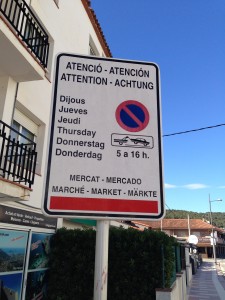A advantage of living in the south of France is that you are never far from the north of Spain.
From the Beziers area, one can reach the border in about 90 minutes. Another half hour or so puts you near Girona as well as the Costa Brava vacation sites.
Which is a nice place to visit on May Day, a month or so ahead of the crush of tourists, particularly British and Dutch tourists, who will descend on the still-off-season and sleepy stretch of shore.
This was the situation:
The wind was howling in the Languedoc. Steady and strong wind, with lots of clouds effectively blocking the sun. The gusts of air were unpleasant, but so too was the February-level temperatures that came with them.
Was this not May 1? More than a month into spring? What’s up with this?
So, instead of looking out the window and wishing we could do something … aside from a punishing hike through knock-you-over gales … the words, “Let’s go find some sun in Spain!” were uttered.
And early in the afternoon, we were on our way.
The Spanish border is something in the back of the minds of people here. The border, on the eastern end of the Pyrenees, is an hour-and-a-half, on the beach soon after. Three hours to reach the outskirts of Barcelona, one of the modern world’s most interesting cities.
This time, we were interested more in sun and a view of the Mediterranean and, after 30 minutes after leaving the AP7 highway and driving through the still-green Spanish/Catalan countryside, we reached the water at a town named L’Estartit, year-round population 3,500.
The wind was blowing there, too, but at least we had sun and light.
This was not a particularly well-planned trip, so when we arrived at about 3:30 we were most interested in lunch. Luckily, a few places were still serving lunch (dinner in Spain is a 9-or-10 p.m. event, remember) and got in out of the wind.
The waitress/manager pointed out a “large tapas plate for two” on the menu and we said “sure” and I ordered a Leffe brown beer, which was refreshing.
It was one of those pub-and-grub places that can seat at least 60, with another 30 or 40 packed around the bar and some sort of continuous loop of soccer being projected on one wall. (We saw Dutch club PSV Eindhoven versus Cambuur of Leeuwarden, a small side from a smallish town in Frisia.)
Our tapas dish was not awful, though it included far more fried-this–and-thats than we ought to have eaten.
What we found interesting about the town was the sense of expectation. Block after block of apartment buildings and hotels, mostly still vacant but about to be filled. Dozens of restaurants, about to escape the long winter doldrums with two or three months of heavy businss.
The town which, at least before the hordes take over, seems tidy and modern. And just about ready. Aside from grading the large mounds of new sand onto the beach and the parking lot behind it.
The restaurants seem ready, the streets are clean and the condom/dildo dispensing machine (yes, really) seemed ready to go.
This is a town that is particularly multi-lingual, as the street sign (above) suggests.
No fewer than six languages are used there to make sure the driver of a motor vehicle realizes that “Thursday is market day” on a particular street. Catalan, Spanish, French, English, German and Dutch. Might be some sort of EU record.
The glib analysis of the Costa Brava is this: Ruined by its success.
Imagining tens of thousands of young people banging around the town and burning themselves on the beach in July and August … no, not an appealing thought.
But like so many places in the world, a visit before or a bit after high season can show a place in its best light. And when we were done looking around (and found a bunch more open restaurants, down by the harbor), we were only two-hours-and-change from being back home in the Languedoc.


0 responses so far ↓
There are no comments yet...Kick things off by filling out the form below.
Leave a Comment